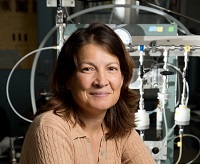Brown Carbon Complicates Black Carbon Action
IMO’s sub-committee on Pollution Prevention and Response has agreed to a definition for black carbon. This definition will now be proposed to the IMO Marine Environment Protection Committee in May (MEPC68) with the idea of agreeing on ways for the shipping industry to reduce its contribution to global emissions.
Unlike carbon dioxide, black carbon is quickly washed out of the atmosphere so it can be eliminated from the atmosphere if emissions are cut. This makes it of particular interest as a potentially quick way to reduce global warming.
The definition of black carbon agreed at the IMO meeting comes from a scientific research paper by Dr Tami Bond and colleagues published in the Journal of Geophysical Research in 2013. “Black carbon is a distinct type of carbonaceous material that is formed primarily in flames, is directly emitted to the atmosphere, and has a unique combination of physical properties. It strongly absorbs visible light, is refractory with a vaporization temperature near 4000K, exists as an aggregate of small spheres, and is insoluble in water and common organic solvents.”
Answering questions as a result of the paper, Bond described black carbon more simply: “Black carbon is a small, dark particle of soot that warms Earth’s climate. It’s the black smoke you might see coming from the tip of a candle or the back of a diesel truck. Black carbon is a particle rather than a greenhouse gas, but it is the second largest climate warmer, after carbon dioxide. Black carbon absorbs sunlight and heats the atmosphere. It also darkens snow and accelerates melting. It can change the brightness of water and ice clouds.”
 Black carbon comes from poor combustion, says Bond. “In the United States, its sources are mainly diesel engines and open forest burning. Other sources around the world include wood and coal burning in homes, some kinds of industry, kerosene lamps, and open savanna burning. Concentrations of particles are largest around cities, but black carbon travels as far as remote oceans and the Arctic.”
Black carbon comes from poor combustion, says Bond. “In the United States, its sources are mainly diesel engines and open forest burning. Other sources around the world include wood and coal burning in homes, some kinds of industry, kerosene lamps, and open savanna burning. Concentrations of particles are largest around cities, but black carbon travels as far as remote oceans and the Arctic.”
The largest global sources are open burning of forests and savannas, states Bond in the paper. Dominant emitters of black carbon from other types of combustion depend on the location. Residential solid fuels (i.e., coal and biomass) contribute 60 to 80 percent of Asian and African emissions, while on-road and off-road diesel engines contribute about 70 percent of emissions in Europe, North America and Latin America. Residential coal is a significant source in China.
These sources represent about 90 percent of black carbon emissions. Other sources such as aviation, shipping and flaring account for another nine percent.
Bond’s study states that shipping contributes about two percent of global black carbon emissions, but it might constitute a larger fraction of direct emissions in remote regions such as the Arctic where there are few other sources. The Arctic has high surface albedo (a measure of the reflectivity of the earth’s surface) due to snow and ice cover, so it is of potential importance with respect to its potential to reflect heat from the sun and therefore limit global warming.
After four years of debate, the move to accept Bond’s definition at IMO has been welcomed by environmental NGO Transport & Environment: For the NGO, it is a clear signal for morer discussion on banning the use of heavy fuel oil in the Arctic. “Lack of agreement at sub-committee level had been holding up technical work to calibrate and test black carbon measurement methods that could be used to evaluate control measures as well as monitoring and engine certification technology.”
IMO is yet to determine how it will proceed with measuring and controlling black carbon. Measurement is not simple because the dark matter found in snow and clouds is not pure black carbon. When produced by burning biomass or fossil fuels, black carbon is accompanied by varying amounts of brown organic carbon. Brown carbon is a complex mixture of organic compounds lacking a formal analytical definition, states Bond in the paper.
Dust is also present in the atmosphere and can affect albedo. Most dust originates from deserts with smaller amounts coming from construction, traffic and agriculture. Although dust is more weakly light absorbing than black carbon, its impact can be significant due to its relatively high abundance.
The atmospheric lifetime of black carbon, its impact on clouds, and its optical properties depend on interactions with these other components, and many methods used to measure black carbon can be affected by their presence. According to the Brown paper, concentration measurements can differ between methods by up to 80 percent.
According to the NGO International Council for Clean Transportation, fuel switching, scrubbers, filters and slow steaming are priority control strategies worthy of investigation for the shipping industry.
The opinions expressed herein are the author's and not necessarily those of The Maritime Executive.
